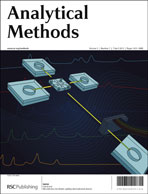Microelectrode array (MEA) was used for in situ heavy metal determination in aquatic environments due to its characteristics of high sensitivity, large current density and fast mass transfer rate, while interferences caused by background factors and complex external environment were inevitable in analysis leading to inaccurate results. Hence, two algorithms, partial least square regression and local optimum method were employed in different situations for electrochemical analysis to eliminate interference. Partial least square regression was superior to local optimum method thanks to convenient operations and good outcomes for in situ determination, which was proved to be effective in low interference samples. Nevertheless, inaccurate results were obtained in samples of complicated composition because of negative impacts on working electrode. Local optimum method was proposed aiming at those situations, by which severe interference was ignored and better results were acquired to prove the reasonability and validity of the algorithm. The determination of cadmium and lead was improved effectively combined PLS with local optimum method.

You have access to this article
 Please wait while we load your content...
Something went wrong. Try again?
Please wait while we load your content...
Something went wrong. Try again?


 Please wait while we load your content...
Please wait while we load your content...